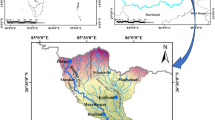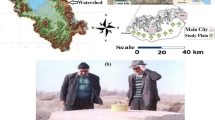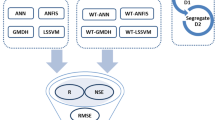Abstract
In the present study, for the first time, a new framework is used by combining metaheuristic algorithms, decomposition and machine learning for flood frequency analysis under climate-change conditions and application of HadCM3 (A2 and B2 scenarios), CGCM3 (A2 and A1B scenarios) and CanESM2 (RCP2.6, RCP4.5 and RCP8.5 scenarios) in global climate models (GCM). In the proposed framework, Multivariate Adaptive Regression Splines (MARS) and M5 Model tree are used for classification of precipitation (wet and dry days), whale optimization algorithm (WOA) is considered for training least square support vector machine (LSSVM), wavelet transform (WT) is used for decomposition of precipitation and temperature, LSSVM-WOA, LSSVM, K nearest neighbor (KNN) and artificial neural network (ANN) are performed for downscaling precipitation and temperature, and discharge is simulated under present period (1972–2000), near future (2020–2040) and far future (2070–2100). Log normal distribution is used for flood frequency analysis. Furthermore, analysis of variance (ANOVA) and fuzzy method are employed for uncertainty analysis. Karun3 Basin, in southwest of Iran, is considered as a case study. Results indicated that MARS performed better than M5 model tree. In downscaling, ANN and LSSVM_WOA slightly outperformed other machine learning algorithms. Results of simulating the discharge showed superiority of LSSVM_WOA_WT algorithm (Nash-Sutcliffe efficiency (NSE) = 0.911). Results of flood frequency analysis revealed that 200-year discharge decreases for all scenarios, except CanESM2 RCP2.6 scenario, in the near future. In the near and far future periods, it is obvious from ANOVA uncertainty analysis that hydrological models are one of the most important sources of uncertainty. Based on the fuzzy uncertainty analysis, HadCM3 model has lower uncertainty in higher return periods (up to 60% lower than other models in 1000-year return period).









Similar content being viewed by others
Data Availability
All data generated or used during the study are applicable if requested.
References
Ahmadi A, Moridi A, Lafdani EK, Kianpisheh G (2014) Assessment of climate change impacts on rainfall using large scale climate variables and downscaling models- a case study. J Earth Syst Sci 123:1603–1618. https://doi.org/10.1007/s12040-014-0497-x
Alizadeh MJ, Kavianpour MR, Kisi O, Nourani V (2017) A new approach for simulating and forecasting the rainfall-runoff process within the next two months. J Hydrol 548:588–597. https://doi.org/10.1016/j.jhydrol.2017.03.032
Aljarah I, Faris H, Mirjalili S (2018) Optimizing connection weights in neural networks using the whale optimization algorithm. Soft Comput 22:1–15. https://doi.org/10.1007/s00500-016-2442-1
Araghinejad S (2013) Data-driven modeling: using MATLAB®. In: Water resources and environmental engineering, Springer, Dordrecht, The Netherlands
Aryal A, Shrestha S, Babel MS (2019) Quantifying the sources of uncertainty in an ensemble of hydrological climate-impact projections. Theor Appl Climatol 135:193–209. https://doi.org/10.1007/s00704-017-2359-3
Azad A, Kashi H, Farzin S, Singh VP, Kisi O, Karami H, Sanikhani H (2020) Novel approaches for air temperature prediction: a comparison of four hybrid evolutionary fuzzy models. Meteorol Appl 27:e1817. https://doi.org/10.1002/met.1817
Azmat M, Qamar MU, Ahmed S, Shahid MA, Hussain E, Ahmad S, Khushnood RA (2018) Ensembling downscaling techniques and multiple GCMs to improve climate change predictions in cryosphere scarcely-gauged catchment. Water Resour Manag 32:3155–3174. https://doi.org/10.1007/s11269-018-1982-9
Bhattacharya B, Solomatine DP (2005) Neural networks and M5 model trees in modelling water level-discharge relationship. Neurocomputing 63:381–396. https://doi.org/10.1016/j.neucom.2004.04.016
Bosshard T, Carambia M, Goergen K, Kotlarski S, Krahe P, Zappa M, Schär C (2013) Quantifying uncertainty sources in an ensemble of hydrological climate‐impact projections. Water Resour Res 49:1523–1536
Bui QT, Van Pham M, Nguyen QH, Nguyen LX, Pham HM (2019) Whale optimization algorithm and adaptive neuro-fuzzy inference system: a hybrid method for feature selection and land pattern classification. Int J Remote Sens 40:5078–5093. https://doi.org/10.1080/01431161.2019.1578000
Camici S, Brocca L, Melone F, Moramarco T (2014) Impact of climate change on flood frequency using different climate models and downscaling approaches. J Hydrol Eng 19:04014002. https://doi.org/10.1061/(ASCE)HE.1943-5584.0000959
Chen H, Guo J, Xiong W, Guo S, Xu CY (2010) Downscaling GCMs using the smooth support vector machine method to predict daily precipitation in the Hanjiang Basin. Adv Atmos Sci 27:274–284. https://doi.org/10.1007/s00376-009-8071-1
Chen H, Xu CY, Guo S (2012) Comparison and evaluation of multiple GCMs, statistical downscaling and hydrological models in the study of climate change impacts on runoff. J Hydrol 434-435:36–45. https://doi.org/10.1016/j.jhydrol.2012.02.040
Chong KL, Lai SH, Yao Y, Ahmed AN, Wan Jaafar WZ, El-Shafie A (2020) Performance enhancement model for rainfall forecasting utilizing integrated wavelet-convolutional neural network. Water Resour Manag 34:2371–2387. https://doi.org/10.1007/s11269-020-02554-z
Das J, Nanduri UV (2018) Assessment and evaluation of potential climate change impact on monsoon flows using machine learning technique over Wainganga River basin, India. Hydrol Sci J 63:1020–1046. https://doi.org/10.1080/02626667.2018.1469757
De Niel J, Van Uytven E, Willems P (2019) Uncertainty analysis of climate change impact on river flow extremes based on a large multi-model ensemble. Water Resour Manag 33:4319–4333. https://doi.org/10.1007/s11269-019-02370-0
Dibike YB, Gachon P, St-Hilaire A, Ouarda TBMJ (2008) Uncertainty analysis of statistically downscaled temperature and precipitation regimes in northern Canada. Theor Appl Climatol 91:149–170. https://doi.org/10.1007/s00704-007-0299-z
Du P, Wang J, Yang W, Niu T (2018) Multi-step ahead forecasting in electrical power system using a hybrid forecasting system. Renew Energy 122:533–550. https://doi.org/10.1016/j.renene.2018.01.113
Ehteram M, Mousavi SF, Karami H, Farzin S, Singh VP, Chau KW, El-Shafie A (2018) Reservoir operation based on evolutionary algorithms and multi-criteria decision-making under climate change and uncertainty. J Hydroinf 20:332–355. https://doi.org/10.2166/hydro.2018.094
Farzin S, Nabizadeh Chianeh F, Valikhan Anaraki M, Mahmoudian F (2020) Introducing a framework for modeling of drug electrochemical removal from wastewater based on data mining algorithms, scatter interpolation method, and multi criteria decision analysis (DID). J Clean Prod 266:122075. https://doi.org/10.1016/j.jclepro.2020.122075
Friedman JH (1991) Multivariate adaptive regression splines. Ann Stat 19:1–67. https://doi.org/10.1214/aos/1176347963
Ghosh S (2010) SVM-PGSL coupled approach for statistical downscaling to predict rainfall from GCM output. J Geophys Res 115:D22102. https://doi.org/10.1029/2009JD013548
Hadi SJ, Tombul M (2018) Streamflow forecasting using four wavelet transformation combinations approaches with data-driven models: a comparative study. Water Resour Manag 32:4661–4679. https://doi.org/10.1007/s11269-018-2077-3
Keshtegar B, Heddam S, Kisi O, Zhu SP (2019) Modeling total dissolved gas (TDG) concentration at Columbia River basin dams: High-order response surface method (H-RSM) vs. M5Tree, LSSVM, and MARS. Arab J Geosci 12:–544. https://doi.org/10.1007/s12517-019-4687-3
Kundu S, Khare D, Mondal A (2017) Future changes in rainfall, temperature and reference evapotranspiration in the Central India by least square support vector machine. Geosci Front 8:583–596. https://doi.org/10.1016/j.gsf.2016.06.002
Lee KT, Hung WC, Meng CC (2008) Deterministic insight into ANN model performance for storm runoff simulation. Water Resour Manag 22:67–82. https://doi.org/10.1007/s11269-006-9144-x
Malekzadeh M, Kardar S, Saeb K, Shabanlou S, Taghavi L (2019) A novel approach for prediction of monthly ground water level using a hybrid wavelet and non-tuned self-adaptive machine learning model. Water Resour Manag 33:1609–1628. https://doi.org/10.1007/s11269-019-2193-8
Mallat SG (1989) A theory for multiresolution signal decomposition: the wavelet representation. IEEE Trans Pattern Anal Mach Intell 11:674–693. https://doi.org/10.1109/34.192463
Mirjalili S, Lewis A (2016) The whale optimization algorithm. Adv Eng Softw 95:51–67. https://doi.org/10.1016/j.advengsoft.2016.01.008
Modaresi F, Araghinejad S, Ebrahimi K (2018) A comparative assessment of artificial neural network, generalized regression neural network, least-square support vector regression, and k-nearest neighbor regression for monthly streamflow forecasting in linear and nonlinear conditions. Water Resour Manag 32:243–258. https://doi.org/10.1007/s11269-017-1807-2
Mohammadi M, Farzin S, Mousavi SF, Karami H (2019) Investigation of a new hybrid optimization algorithm performance in the optimal operation of multi-reservoir benchmark systems. Water Resour Manag 33:4767–4782. https://doi.org/10.1007/s11269-019-02393-7
Moriasi DN, Arnold JG, Van Liew MW, Bingner RL, Harmel RD, Veith TL (2007) Model evaluation guidelines for systematic quantification of accuracy in watershed simulations. Trans ASABE 50:885–900. https://doi.org/10.13031/2013.23153
Najafi R, Hessami Kermani MR (2017) Uncertainty modeling of statistical downscaling to assess climate change impacts on temperature and precipitation. Water Resour Manag 31:1843–1858. https://doi.org/10.1007/s11269-017-1615-8
Nash JE, Sutcliffe JV (1970) River flow forecasting through conceptual models part I- a discussion of principles. J Hydrol 10:282–290. https://doi.org/10.1016/0022-1694(70)90255-6
Nasseri M, Tavakol-Davani H, Zahraie B (2013) Performance assessment of different data mining methods in statistical downscaling of daily precipitation. J Hydrol 492:1–14. https://doi.org/10.1016/j.jhydrol.2013.04.017
Nourani V, Baghanam AH, Gokcekus H (2018) Data-driven ensemble model to statistically downscale rainfall using nonlinear predictor screening approach. J Hydrol 565:538–551. https://doi.org/10.1016/j.jhydrol.2018.08.049
Parisouj P, Mohebzadeh H, Lee T (2020) Employing machine learning algorithms for streamflow prediction: a case study of four river basins with different climatic zones in the United States. Water Resour Manag 34:4113–4131. https://doi.org/10.1007/s11269-020-02659-5
Qi W, Zhang C, Fu G, Zhou H, Liu J (2016) Quantifying uncertainties in extreme flood predictions under climate change for a medium-sized basin in northeastern China. J Hydrometeorol 17:3099–3112. https://doi.org/10.1175/JHM-D-15-0212.1
Quinlan JR (1992) Learning with continuous classes. In: 5th Australian joint conference on artificial intelligence 92:343–348
Sanikhani H, Deo RC, Samui P, Kisi O, Mert C, Mirabbasi R, Gavili S, Yaseen ZM (2018) Survey of different data-intelligent modeling strategies for forecasting air temperature using geographic information as model predictors. Comput Electron Agric 152:242–260. https://doi.org/10.1016/j.compag.2018.07.008
Sarzaeim P, Bozorg-Haddad O, Bozorgi A, Loáiciga HA (2017) Runoff projection under climate change conditions with data-mining methods. J Irrig Drain Eng 143:04017026. https://doi.org/10.1061/(ASCE)IR.1943-4774.0001205
Singh KK, Pal M, Singh VP (2010) Estimation of mean annual flood in Indian catchments using backpropagation neural network and M5 model tree. Water Resour Manag 24:2007–2019. https://doi.org/10.1007/s11269-009-9535-x
Souvignet M, Heinrich J (2011) Statistical downscaling in the arid Central Andes: uncertainty analysis of multi-model simulated temperature and precipitation. Theor Appl Climatol 106:229–244. https://doi.org/10.1007/s00704-011-0430-z
Suykens JA (2001) Nonlinear modelling and support vector machines. Proceedings of the 18th IEEE instrumentation and measurement technology conference. Rediscovering measurement in the age of informatics (Cat. No. 01CH 37188) IEEE 1:287–294
Tavakol-Davani H, Nasseri M, Zahraie B (2013) Improved statistical downscaling of daily precipitation using SDSM platform and data-mining methods. Int J Climatol 33:2561–2578. https://doi.org/10.1002/joc.3611
Tharwat A, Hassanien AE (2018) Chaotic antlion algorithm for parameter optimization of support vector machine. Appl Intell 48:670–686. https://doi.org/10.1007/s10489-017-0994-0
Tripathi S, Srinivas VV, Nanjundiah RS (2006) Downscaling of precipitation for climate change scenarios: a support vector machine approach. J Hydrol 330:621–640. https://doi.org/10.1016/j.jhydrol.2006.04.030
Valikhan-Anaraki M, Mousavi SF, Farzin S, Karami H, Ehteram M, Kisi O, Fai CM et al (2019) Development of a novel hybrid optimization algorithm for minimizing irrigation deficiencies. Sustain 11:2337. https://doi.org/10.3390/su11082337
Wang F, Huang GH, Fan Y, Li YP (2020) Robust subsampling ANOVA methods for sensitivity analysis of water resource and environmental models. Water Resour Manag 34:3199–3217. https://doi.org/10.1007/s11269-020-02608-2
Willmott CJ, Robeson SM, Matsuura K (2012) A refined index of model performance. Int J Climatol 32:2088–2094. https://doi.org/10.1002/joc.2419
Zadeh LA (1965) Fuzzy sets. Inf Control 8:338–353. https://doi.org/10.1016/S0019-9958(65)90241-X
Zhang Y, You Q, Chen C, Ge J (2016) Impacts of climate change on streamflows under RCP scenarios: a case study in Xin River basin, China. Atmos Res 178-179:521–534. https://doi.org/10.1016/j.atmosres.2016.04.018
Zhang X, Wang H, Peng A, Wang W, Li B, Huang X (2020) Quantifying the uncertainties in data-driven models for reservoir inflow prediction. Water Resour Manag 34:1479–1493. https://doi.org/10.1007/s11269-020-02514-7
Zhao S, Wang L (2010) Support vector regression based on particle swarm optimization for rainfall forecasting. In 2010 Third International Joint Conference on Computational Science and Optimization, IEEE 2:484–487
Funding
The research has not been supported through any funds.
Author information
Authors and Affiliations
Corresponding author
Ethics declarations
Competing Interests
The authors declare that they have no conflict of interest.
Ethical Approval
Not applicable.
Consent to Participate
The authors have made a significant contribution to this manuscript, have seen and approved the final manuscript.
Consent to Publish
The authors have agreed to publish the study in water resource management.
Additional information
Publisher’s Note
Springer Nature remains neutral with regard to jurisdictional claims in published maps and institutional affiliations.
Rights and permissions
About this article
Cite this article
Anaraki, M.V., Farzin, S., Mousavi, SF. et al. Uncertainty Analysis of Climate Change Impacts on Flood Frequency by Using Hybrid Machine Learning Methods. Water Resour Manage 35, 199–223 (2021). https://doi.org/10.1007/s11269-020-02719-w
Received:
Accepted:
Published:
Issue Date:
DOI: https://doi.org/10.1007/s11269-020-02719-w




